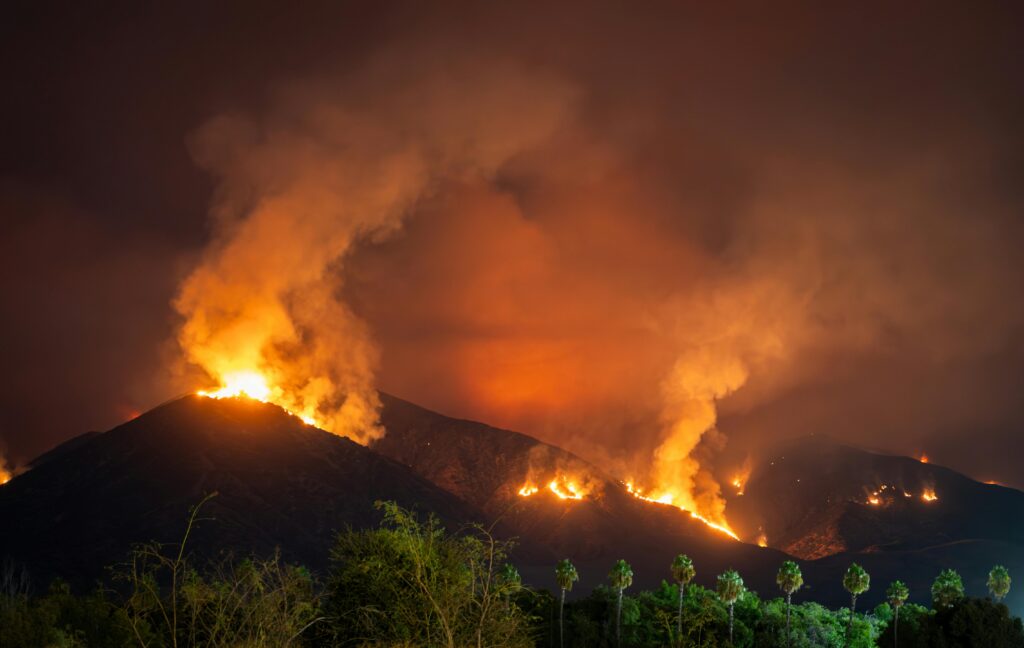
In a concerning development this week, wildfires have intensified across the forests of Northern and Central India, posing severe threats to ecosystems, local communities, and air quality. The fires, fueled by a deadly mix of rising temperatures, dry winds, and human activity, have rapidly spread across states like Uttarakhand, Himachal Pradesh, Madhya Pradesh, and Chhattisgarh.
Forest officials, environmentalists, and residents are grappling with the dual challenge of containing the flames while safeguarding wildlife and human health. Experts warn that if immediate steps are not taken, the situation could escalate further in the coming weeks, leading to irreversible damage to India’s already fragile natural habitats.
Rising Incidents and Affected Areas
According to the Forest Survey of India (FSI), over 1,200 fire incidents have been reported since the beginning of April, with a significant spike recorded in the past ten days. Satellite images show clusters of fire alerts across the dense forests of Uttarakhand’s Kumaon and Garhwal regions, parts of Himachal’s Kullu and Mandi districts, and widespread outbreaks in Madhya Pradesh’s Satpura and Chhattisgarh’s Bastar regions.
“Every year we witness forest fires, but this season is particularly harsh,” said Dr. Ramesh Chandra, a forest officer in Uttarakhand. “The combination of record-high temperatures and prolonged dry spells has created a tinderbox situation. Even a small spark is enough to set off massive fires.”
Locals in the affected areas have reported thick smoke engulfing their villages, reduced visibility, and breathing difficulties. In Chhattisgarh’s Bastar, tribal communities dependent on forest produce are facing disruptions to their livelihoods as fires sweep through tendu leaf forests and minor produce collection areas.
Contributing Factors Behind the Surge
While forest fires are common during India’s dry summer season, experts point out that the intensity and frequency of fires are worsening due to a combination of natural and anthropogenic factors:
- Climate Change: Rising temperatures and erratic rainfall patterns have dried out forest floors, making them more susceptible to ignition. This year, India recorded one of its hottest April months in decades.
- Human Activities: Slash-and-burn agriculture practices, accidental campfires, illegal logging, and the careless disposal of cigarettes are significant contributors. In some cases, fires are also deliberately set to clear land or stimulate the growth of new vegetation.
- Weak Enforcement and Preparedness: Although fire prevention plans exist, they are often poorly implemented due to limited resources, lack of coordination, and understaffed forest departments.
Dr. Anita Joshi, an ecologist based in Delhi, emphasized, “Climate change acts like an amplifier. Traditional practices that might have caused minor fires in the past now escalate into major disasters because of the hotter and drier conditions.”
Environmental and Health Impacts
The consequences of the wildfires are already being felt widely:
- Biodiversity Loss: Many forest areas burning are rich in biodiversity, including critical habitats for species like the Himalayan black bear, Indian giant squirrel, and various endemic birds and reptiles. With fires destroying nesting sites and food sources, long-term ecological imbalances are inevitable.
- Air Quality Decline: Cities like Dehradun, Shimla, and Raipur have witnessed a sharp dip in air quality indices over the past week. The fine particulate matter from forest fires is a major health hazard, particularly for children, the elderly, and those with respiratory illnesses.
- Water Scarcity Threats: Forests play a crucial role in maintaining the water cycle. Damage to vegetation reduces groundwater recharge and affects river systems downstream, potentially leading to water shortages in the dry months ahead.
- Economic Impact: Tourism, a vital sector for many hill states, is also taking a hit. Several trekking routes, nature reserves, and adventure tourism hotspots have been temporarily closed due to safety concerns.
Ongoing Efforts to Control the Fires
State forest departments, along with the National Disaster Response Force (NDRF), are engaged in firefighting operations. More than 5,000 personnel have been deployed in the worst-affected regions, aided by fire beaters, water tankers, and in some areas, drone surveillance to monitor fire spread.
In Uttarakhand, authorities have also employed controlled burns, where small, manageable fires are deliberately lit to remove combustible material, thereby creating firebreaks. Similarly, awareness campaigns are being run in vulnerable villages to educate locals about fire prevention and early reporting.
However, officials admit that the rugged terrain and inaccessible forest interiors make firefighting extremely challenging. “Many fires are located in steep, forested hillsides where even reaching the firefront is risky and difficult,” said Rajesh Rawat, a senior fire officer in Almora.
Calls for Stronger Action and Policy Reforms
Environmentalists are calling for urgent and systemic reforms to tackle the wildfire crisis more effectively:
- Better Early Warning Systems: Investment in real-time satellite monitoring, artificial intelligence-based fire prediction models, and community-based surveillance networks.
- Stronger Forest Management: Regular clearing of dry biomass, maintenance of firelines, and greater involvement of local communities in forest governance.
- Climate Action: Addressing the root cause by intensifying efforts to mitigate climate change through renewable energy adoption, afforestation drives, and stricter environmental regulations.
- Increased Funding: Allocation of more funds for forest departments to improve training, buy modern firefighting equipment, and hire adequate personnel.
“There is an urgent need to rethink our relationship with nature,” Dr. Joshi added. “Our forests are not just sources of timber or tourist revenue. They are living ecosystems essential for our survival. Protecting them must become a national priority.”
A Grim Warning for the Future
The ongoing wildfire crisis serves as a stark reminder of the growing vulnerabilities brought about by climate change, unplanned development, and neglect of natural resources. As India heads deeper into the summer, forest departments fear that unless strong preventive measures are taken, the fires could worsen, with devastating consequences for biodiversity, human health, and the economy.
For now, the priority remains containment. But experts agree that the real battle lies in long-term sustainable forest management and addressing the broader environmental challenges that make such disasters more frequent and more deadly.